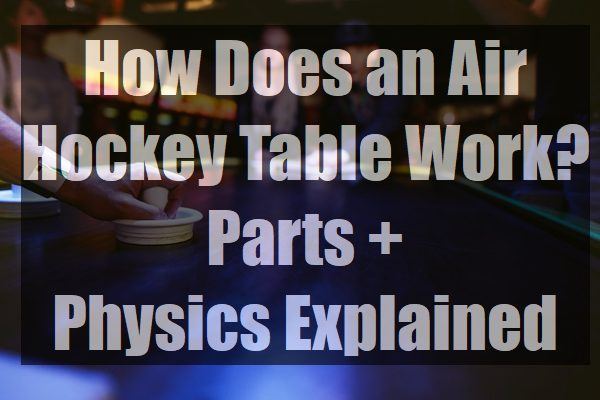
How Does an Air Hockey Table Work? Parts + Physics Explained
You love hockey but you do not know how to skate that well on ice. Thankfully there is a hockey alternative. Air hockey games provide a lot of fun, competition and hours of entertainment.
How Does an Air Hockey Table Work? Air hockey games use air holes and a blower to send air to the surface of the game. A plastic puck is dropped and each player holding a paddle strike the puck, hoping to slide it into their opponent’s goal.
That is the game in a nutshell. To get the science behind the game all you have to do is continue to read our article. We take the game apart and closely examine how the game works technically.
How Does Air Hockey Work
The makers of air hockey put together a very slick surface, usually a laminate cover over plywood or MDF board, then form paddles and pucks out of plastic to make the most of the air flowing out of the hundreds of tiny holes in the slick surface.
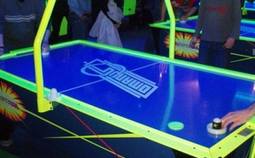
The two players strike the puck, sometimes ricocheting it off the walls, in hopes of trying to get past their opponent’s defenses. The cushion of air helps the puck slide and avoid any friction. This makes the game very fast and you need good reflexes to stay in the game.
Players are not allowed to touch the puck with any part of their bodies and they can only use one hand on the mallet or paddle. Trapping the puck is a penalty and the player doing that loses possession of the puck and a chance to score.
One key to the game is to learn how to bounce the puck off the boards or your opponent’s mallet and get the puck into his or her goal. And you thought geometry was not going to be of any use to you.
Another key to the game is to make sure the laminated surface remains slick. Once it does you have some repair work to do or your puck will not slide like it is supposed to.
Physics Behind Air Hockey
It is a good bet that most of our readers skipped physics class when they were in high school. And the physics behind air hockey can get a bit complicated but we will try to simplify everything so you can understand how the game works from a scientific point of view.
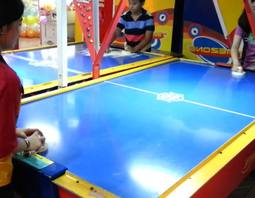
First, the very basics of physics tells us that “every action has an equal and opposite reaction”. This means that when you hit the puck with the paddle it is going to speed off in the opposite direction from where you are standing
Second, “Acceleration of an object depends on the object's mass and the net force acting upon it” What this means is that the speed of the puck heading towards your goal depends on its weight, size and how hard it was hit.
Third, “An abject at rest tends to remain at rest and an object in motion tends to remain in motion in the same speed and direction unless acted upon by an unbalanced force”
In other words, the puck will move at a constant speed and direction due to the air flow coming out of the air holes until struck by one of the players’ paddle.
Trying to calculate the average speed will be a little but more difficult. The puck travels at a variety of speeds throughout the game depending on how hard it was hit each time.
Air Hockey Table Physics
When it comes to using science to figure out how air hockey works, you will inevitably be faced with differing opinions. We will provide one opinion here and if you disagree with it, that is okay.
First things first. To make a 2 1/2 inch puck move that doe snot weigh a lot, it is not the amount of air holes it covers when it slides across the table. Nor is it the size of those holes that matters.
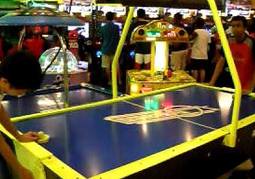
What counts is the amount of air pressure coming through those holes. This pressure should be uniform but that may not always be the case. The equation to figure out how much pressure you need to lift and move that size and weight of puck is as follows: P = .040466 lb / (pi/4*2.5^2) = .00824 psi
The first figure after P is the weight of the puck. If there is enough pressure coming out of the air holes, then the puck should be elevated from the table and move freely across the surface. If the pressure drops,so does the puck and the game will stop for a while.
If you want to calculate how big the air holes should be, then you would have to figure out the flow curve of your air blower.
Air Hockey Working Principle
When it comes to science many people have caught up on their sleep throughout their science lectures. Hopefully you have not fallen asleep by now. The science behind the game can get fairly technical and boring.
If you haven’t figured it out just yet, the working principle of air hockey is to have enough air flow and air pressure flowing through the surface of the game to move a plastic puck.
That movement is then altered by one of two players striking the puck and sending it into their opponent’s goal. Both opponents are to construct a defense to keep that objective from taking place, while creating shots to overcome those defensive measures.
Now that was the technical working principle of air hockey. The other working principle is more practical. It is a game that was developed for those people who like hockey but do not have the time or skills to do so.
The game allows them to have fun with family and friends without the expense and investment of time that is required to play real hockey. This fun can take place anywhere and any time you are free to get a little exercise as well as spend some quality time with your friends and family.
It is also a great way to work off steam and excess energy while getting a little healthy exercise. Your healthy lifestyle will be enhanced if you add air hockey to your entertainment schedule.
The Parts of the Air Hockey Table
It turns out that air hockey can be quite addicting. Its fast pace, the intensity levels and highly competitive nature seems to hook many players and they cannot get enough of the game.
Some people have gone as far as creating a professional league for air hockey players who think their talents are superior to other players. The good news is that air hockey is a very simple game and unlike real hockey it doesn't require pads, masks, helmets or other protective equipment.
In fact, the less equipment and clothing that restricts arm movement is ideal. The game is very basic and simple to operate, although you can get electronic scoreboards, flashing LED lights, sound effects and other accessories. But those are not for the serious player.
Depending on the style of the air hockey game you buy, you will get a basic table, a puck, two mallets, an air blower and usually a built-in manual scoreboard. That is all you really need to play the game.
Everything else is for entertainment value only. One part of the game that is also very important is an air hockey table cover. This protects your game from damage and keeps the surface nice and clean.
Air Hockey Parts Names
Each air hockey part does have its own name and its own style of construction material. Playing the game well demands that you know the game thoroughly.
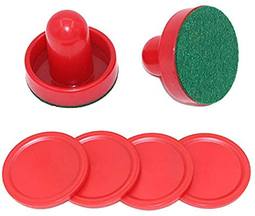
The Puck- this is a round disc that can measure between 2 and 3 1/2 inches in diameter. You need to have the right size and weight for the table you are playing on or they may fly off and delay the game. Official pucks are made from one type of plastic like material and other materials will not be accepted.
The Mallet- these are what you use to move the puck towards your opponent’s goal. They are also called a striker or a paddle. The best striker has a groove between the back wall and the handle. There are a variety of designs and you can choose which one fits you the best
The air blower- or more commonly known as the air fan. This blower produces the CFMs you need to move the puck across the laminated surface of your air hockey table. A too powerful fan will lift the puck and striking it will send it flying. A less powerful blower won;t move the puck that much and the fun is lost
The scoreboard- the name says it all. This part keeps track of the score so there are no arguments over who won and who lost. These come i manual, electronic and digital versions.
The surface- or also called the table top. This is the laminated surface that has all the air holes. This combination allows your puck to move freely and easily as you play. The key to a good air hockey game is not to damage the surface as it can be a bit difficult to repair or replace.
The air hockey table- this comprises of the body of the game, the walls to bounce the puck off of and the legs. It holds the blower in position so you get the right air flow and is usually made of MDF wood. A good game is strong, durable and should be able to handle a very intense game.
Inside an Air Hockey Table
You are probably content knowing that the air is coming out of its little air holes correctly and you are having a lot of fun playing the game. For those who want to know all about an air hockey game here is a brief look at what is inside.
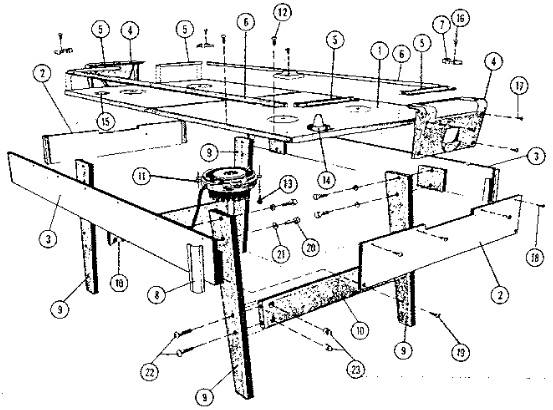
The first thing you will see when you look underneath the game should be the floor of the motor compartment. This helps keep the air inside the game and moving upwards towards the holes.
A plastic casing may surround the blower and its motor. This provides a little protection for the blower. Then there should be small channels to guide the air to the box underneath the surface. This box helps force the air up towards the air hole and helps maintain the air pressure needed.
How to Make an Air Hockey Table Work Better
It is not that hard to improve the quality of your air hockey table to make it work better. Here are some simple tips to guide you as you go to the next level of your air hockey playing:
- Change blowers- if the blower is not producing enough air pressure or it is producing too much, change it to one that will get the air pressure just right
- Clean the table- regular cleaning will remove friction, dirt, grime and free up clogged air holes
- Cover your table- when you are not playing the game, keep it covered so dust, dirt and grime do not add friction,plug holes or get down into the blower
- Change pucks- you may be using a puck that is not the right weight or size for your table. If this is the case find out what size and weight puck you need and replace the old pucks with the correct version
- Wax the surface- if you do this lightly, you shouldn’t clog the air holes and you should cut the friction down making your table slicker.
Some Final Comments
Air hockey can be a lot of fun even if you do not know all the scientific principles or technical details involved in the game. It may be good to know that you can put those geometry and physics lessons to practical use once you start to play.
The science behind air hockey does not diminish its fun. It just adds to it. Knowing the inner workings of the game can help you create great strategies to defeat your next opponent.
It will also help you design a defense to keep their shots out of your goal.

